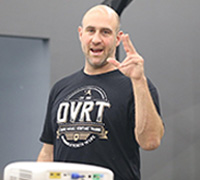Why We Still Get Shoulder Mobility so Wrong!
-Josh Henkin, CSCS
I’m actually a HUGE believer in good mobility training! However, I am also cautious though, for many people to fall into the trap of ineffective and inefficient shoulder mobility forms of training. I can say this because I am not smarter than everyone, but because I have been the victim of such training with my clients and my own mobility in the past.
When I was still finishing college in the late 90’s I was also training people. Not only was I training people I was already going to continuing education programs in the field I was pursuing. I felt like I was on the accelerated path because I wasn’t just relying on my degree in Exercise Science, but also seeing what real leading coaches in the industry were doing. Not too surprising there was a big emphasis on mobility training even back then and I went through quite a few of mobility programs (some that have been repackaged in today’s world of fitness under different names). Wanting to do the right thing I tried what all these mobility programs had to offer, some worked a bit better than others, but nothing worked tremendously well to help my clients, or myself for that matter, and yet they all took A LOT of time to perform.

There was a point that the mobility training of my clients was taking 30-40 minutes and we only had a little time to train. My clients were not only not seeing the positive changes to their mobility, but also were upset so little time was spent actually training. That is when I went on a mission to better understand mobility because I knew my clients needed it and we had to do it better way.
This is the point I started to realize the mobility training I had been doing was neglecting some major factors that impact movement and what I was doing was the VERY long route of trying to change these qualities of mobility. Today I wanted to share with you my lessons so you can avoid the years of mistakes I made!
Joint Mobility Is A Bit Misleading
Yes, we want to improve the mobility of the joint we are focusing upon and in this case I want to discuss shoulder mobility, however, the idea the problem is a joint issue is a bit misleading. As you can see there are lots of layers of muscles, fascia, nerves, arteries, ligaments, and tendons that all play a part in our shoulder mobility and ability to control our movement.
With this knowledge, it makes sense that we need to think MORE than the isolated joint itself.
The Nervous System Plays A HUGE Role
The issue of the isolated muscle model is that it discounts largely the important role our nervous system plays. Our nervous system plays maybe a bigger part in our mobility training than any other structure as renowned physical therapist, Gray Cook, explains below.

Motor control isn’t what you will hear a lot of people discussing because there is no one muscle that is built with motor control. The easiest way to think of motor control, because it is extremely important, is the way that your muscles coordinate with one another to create seamless movement. If there is a disruption in this communication and chain then dysfunction occurs in our movement and the body will create tension and “tightness” in compensation. When we teach proper motor control (balance of mobility and stability typically) we can reduce the tightness our body experiences which obviously has a big impact on things like our shoulder mobility.
Creating Better Mobility With Stability
Most people think shoulder mobility training shoulder precede overall stability training. I get the confusion, especially when most don’t realize the way we can improve shoulder mobility is through better overall stability. That is due to the fact that the shoulder is largely a byproduct of what happens in the lower body, hips/core, grip, and neck.

Coach Cory Cripe of Fitness Lying Down shows how something that doesn’t look like shoulder mobility in our Ultimate Sandbag press out dead bug series can actually be incredibly effective for shoulder mobility based on these principles.
Since we know that there are SO many factors that can influence our shoulder mobility (just mobility overall) it makes sense to start with the ideas that can have the BIGGEST impact. That is why emphasizing our feet, grip, and core can yield some very quick and impressive improvements in our shoulder mobility. Especially because the lives of people is always going to ask us to address these issues because we don’t get to move nearly as much as we probably should in life and there are other factors that keep us from living how our bodies were designed to function. So, we have powerful tools like what strength coaches Joel Gunterman and Martin Adame show below to have very drastic improvements to how we actually should be looking at shoulder mobility training.
Josh Henkin

Josh is an international presenter and strength coach who has taught in over 13 countries worldwide and consulted with some of the top fitness and performance programs in the world. You can check out his DVRT online fitness educational certifications/courses HERE and get 20% off with code “pb20”

